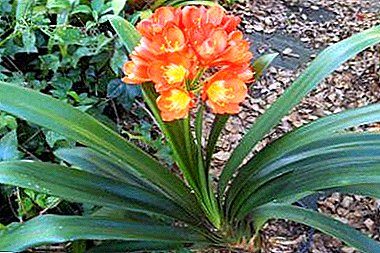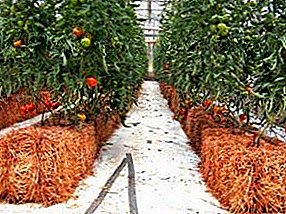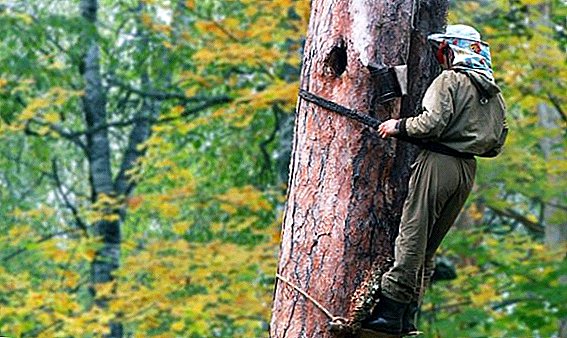 Every autumn, our cottages and private houses are exposed to a real invasion of rodents, hurrying to get comfortable for the winter. If summer residents do not immediately begin to fight the invaders, the family of rodents will grow several times in a matter of months.
Every autumn, our cottages and private houses are exposed to a real invasion of rodents, hurrying to get comfortable for the winter. If summer residents do not immediately begin to fight the invaders, the family of rodents will grow several times in a matter of months.
Description and photos of rodents
Small pests gnaw and spoil everything they can reach. Vegetables harvested for the winter in the cellars, flour and cereals in the house - everything is spoiled by the teeth of rats and mice.
Learn how to deal with snakes, voles, hares, deer, vipers, wasps, ants, bark beetle, weevil, shrew in the dacha.
Rats
Often gardeners are at a loss, not knowing who digs holes in the garden, except for the mole. This uninvited guest on the beds - ground rat.  Outwardly, this animal has little in common with ordinary rats - it looks like a particularly large mouse and is a close relative of the vole mice. The body weight of the animal reaches half a kilogram, the length of the calf - up to 25 centimeters. But this small animal is just a natural disaster for summer residents.
Outwardly, this animal has little in common with ordinary rats - it looks like a particularly large mouse and is a close relative of the vole mice. The body weight of the animal reaches half a kilogram, the length of the calf - up to 25 centimeters. But this small animal is just a natural disaster for summer residents.
They will gladly eat carrots and onions growing in the garden, gnaw up potatoes sitting in the ground, flower bulbs in a flowerbed to empty crusts, and will not disdain weeds.
The earth rat lives underground, moves in underground tunnels, as it advances, eats up the roots of plants, and brings posterity up to five times a year. In each litter the female leads up to 12 cubs. If the owner does not figure out in time how to get rid of unwanted neighbors, in a few years he may have to give up the dacha to pests. 
Did you know? Mountains of trash - this is the reason that rats arrange their homes in houses. Sometimes it is not necessary to poison the rats, and you just need to carry out a general cleaning in the basements and cleaning the garbage chute.
Mice
House mice are small animals of gray or red color. The body weight of the mouse reaches 30-35 grams, and the length of the calf along with the tail is 12-15 cm. In the summer, they can live in a field, forest, or vegetable garden in earthen minks. In winter, they prefer to move to protected premises (cottages, barns, cellars).  In the dwellings of people arrange nests under the floor, in the walls or in attics. Nests are made from rags, straw or paper. Eat grass seeds, grain, happy to eat stocks of people.
In the dwellings of people arrange nests under the floor, in the walls or in attics. Nests are made from rags, straw or paper. Eat grass seeds, grain, happy to eat stocks of people.
Damage and causes
Even if you do not take into account the fact that the rodent neighborhood is just unpleasant, it is often just dangerous for humans. Many infectious diseases are spread by rats and mice (with saliva and droppings).
Did you know? Since the 14th century, the evil glory of the plague peddlers has been dragging behind rats. According to doctors, they were the cause of the outbreak of a pandemic that killed the lives of millions of people.Despite the fact that the plague is almost everywhere defeated, in poor, backward countries, where the level of medicine is extremely low, and the population is high, pockets of this disease periodically occur.
Urban rats and mice usually live in garbage chutes, sewers or landfills. These places are breeding grounds for all sorts of infections, and fast-moving rodents, for which there are almost no obstacles (height, wooden walls, etc.), spread the infection in the city.  Rat excreta enter the city water supply, enriching water with intestinal rods and various viruses. Rats and mice are carriers of tularemia, leptospirosis, rickettsiosis, toxoplasmosis, salmonellosis, rabies and many other dangerous diseases.
Rat excreta enter the city water supply, enriching water with intestinal rods and various viruses. Rats and mice are carriers of tularemia, leptospirosis, rickettsiosis, toxoplasmosis, salmonellosis, rabies and many other dangerous diseases.
Rats and mice cause significant material damage to their neighborhood, gnawing holes in the walls and furniture, destroying food. Rats do not disdain even plastic, often on plastic dishes or furniture you can find traces of their teeth. Rodents can be damaged by electrical wiring, which causes fires. If the owner gapels with the destruction of pests, then the planting material (vegetable seeds, grain, seed potatoes) will be destroyed. 
Getting rid of rodents
Consider all the measures to combat rodents in the country:
- prophylaxis;
- exile;
- scaring off;
- destruction.
Mechanical methods
If, in spite of all our preventive measures, mouse droppings are found in the house, nothing remains but how to deal with mice in the country with traps and traps.  It also happens: the mouse smell is clearly felt, but there is no trace of the rodent. In this case, you need to arrange a search inside the kitchen cabinets, under the bathroom or under the sofas. As a bait, it is worthwhile to put a strong-smelling product into the trap - it can be a piece of bacon or sausage, roasted seeds or cheese. The trap is inspected every day.
It also happens: the mouse smell is clearly felt, but there is no trace of the rodent. In this case, you need to arrange a search inside the kitchen cabinets, under the bathroom or under the sofas. As a bait, it is worthwhile to put a strong-smelling product into the trap - it can be a piece of bacon or sausage, roasted seeds or cheese. The trap is inspected every day.
Important! Dead rodents should not be taken with bare hands: for these purposes it is better to use rubber gloves or a plastic bag.
Humane traps for domestic pests have long been invented. The captured mouse is removed from the trap and carried away from home (in a forest or field), and then released into the wild.
Here are a few options for such traps:
- In the empty plastic bottle, pierce the bottom and strung it on a thick wire, like a skewer. One end of the wire comes out of the bottom of the bottle, the other - from its neck. The length of the wire is twice as long as the length of the bottle. The hole in the bottom is made several times larger than the diameter of the wire, and therefore the bottle rotates freely on the wire pin. The wire with the bottle is placed and fixed over a deep bucket, a piece of fried lard is attached to the top of the bottle. The mouse, attracted by the smell, jumps on the bottle, trying to get the bait. The wobbly construction under the mouse weight turns around the wire axis, and the pest falls into a bucket from which it cannot get out.
- Take a liter glass jar. A thin and wide slice of raw fat is attached to the bottom of the jar (if pressed strongly against the glass, it will hold). An inverted can is placed in the place where the rodent was spotted. Next, the edge of the can is raised, and a large coin is placed between the floor and neck on the rib. Interested in the smell, the mouse will climb into the jar - the hole for this is quite large, but as soon as it comes in to remove the fat attached to the bottom - the coin will slip and the trap will shut.
- An empty bucket is covered on top with a sheet of newspaper. Fix the newspaper with tape, primatyvaya to the bucket neck. Make a cross-section in the middle of the newspaper with a sharp blade. The cut will not be noticeable until the mouse steps on it. For the bait we put a mouse treat at the very cut. The animal, reaching for the bait, will step on the newspaper. The paper will burst and the pest will fall into the bucket.



Earthen rat in the garden can be caught with the help of two shovels, as a mole. When the animal digs a new course, it can be seen its location by the kind of moving loose earth. If the summer resident plunges one shovel behind the diving stroke and another shovel in front of the animal's nose, then both moves (forward and backward) will be blocked, and the animal will only be dug out of the ground with a shovel, taken to the forest and released.
You can take more stringent measures to combat the destroyer of the beds and throw in the course of the poisoned bait, flood the hole or smoke an animal out of the hole. The photo shows the expulsion of rodents from the cellar smoke. 
Did you know? Frightening rats and a sharp mechanical sound. Summer residents stick sticks in the beds with tin covers attached to them on the ropes for preservation. At the slightest wind, the covers sway, touch each other and make an unpleasant roar. From these sounds, not only earth rats but also moles leave the garden.Now on sale there were special glue traps for rats and mice. They are quite effective, only very inhuman. The captured animal dies in torment without food and water, and if it is found still alive, then release it from the glue base and release it will not work - the pest is doomed. In this case, the quick death of a rodent in a mousetrap is better.
 An asbestos trap is also an inhumane one — asbestos or cement is mixed with dry food and spread out near the place of residence of the rodent. Near put a jar of water. After eating the bait, the mouse drinks water and dies within five minutes, as the cementing mixture in the animal's stomach freezes.
An asbestos trap is also an inhumane one — asbestos or cement is mixed with dry food and spread out near the place of residence of the rodent. Near put a jar of water. After eating the bait, the mouse drinks water and dies within five minutes, as the cementing mixture in the animal's stomach freezes.Chemistry
Many decades spent by mankind to fight rodents with poisons. Since the mouse tribe multiplies exponentially, over thousands of mouse generations, the pests have mutated and partially become resistant to many poisons. But a cat or a dog that has eaten a mouse that dined with poison will be doomed to death.
Important! A child may be interested in a bag with rat poison - therefore, it is better to refuse the use of toxic substances in suburban areas where there are children.
Scarers
Consider how to get rid of rats and mice folk remedies. Rodents do not like to be in a room where the floor is covered with ash (stove or fire). The fact is that the ash is alkaline, and while running on it, the mice have to clean their paws every now and then. At the same time, they lick the ash from their paws many times a day.  The alkali contained in the ashes erodes the sky of the animal and creates unpleasant sensations. In a week, the ash-strewn room of the mouse will be abandoned. However, such measures are permissible only for non-residential premises.
The alkali contained in the ashes erodes the sky of the animal and creates unpleasant sensations. In a week, the ash-strewn room of the mouse will be abandoned. However, such measures are permissible only for non-residential premises.
You can try to exorcise the animals with the help of strongly smelling essential oils. For example, peppermint oil is applied on cotton wool and left in various secluded corners of the house. You can sprinkle in the corners with your own hand-prepared spray: two glasses of water are taken on one teaspoon of peppermint.
Not bad have proven ultrasonic rodent repellents, although there are several drawbacks to their work. They help to fight with earth rats and other pests, making an inaccessible sound to the human ear. And how do pets react to this sound?  Dogs are sometimes taken to howl, the cat may leave the house for several days. So it’s up to you whether such a scarer is suitable for your dacha or not. These devices are sold in hardware stores.
Dogs are sometimes taken to howl, the cat may leave the house for several days. So it’s up to you whether such a scarer is suitable for your dacha or not. These devices are sold in hardware stores.
Animals and plants
Pests do not tolerate the smell of mint, wormwood, scorched wool. These substances are laid out in burrows and rodents.
The elder planted on the site banishes the rats from the summer cottage, as the root system of the shrub replenishes the soil with cyanide.
The best way to deal with mice were and remain cats. Even a fed and lazy cat will not leave indifferent a nimble mouse. The very smell of cats will scare rodents from settling on your territory.  Some dog breeds are also excellent rat catchers - for example, dachshunds. Dachshund will bring all the mouse and rat herd in the country, but it can dig up and damage the beds.
Some dog breeds are also excellent rat catchers - for example, dachshunds. Dachshund will bring all the mouse and rat herd in the country, but it can dig up and damage the beds.
Precautionary measures
Try to prevent a mouse invasion. To do this, carefully inspect the cottage. Finding mouse moves, cracks in the floor or other possible loopholes, try to close them, making it impassable for the animals. Small holes tightly clog with glass wool or kitchen metal scrapers for dishes.
Large holes zakachachivat wooden "patches." Check window platbands - if the space under them is empty, fill it with sealant or foam. 
Prevention
Consider how to deal with mice in the country, if you do not want to take cruel measures and spend time and energy to fight. The way out is obvious - not a single rodent will live in an empty cold cottage where there is not a crumb of food within access. All pet food should be removed in non-grit hermetically sealed containers (barrels, cans).
On the stove or on the floor should not be food residues, in addition, do not need to leave access to water and tanks with food debris. Around the house it is undesirable to have heaps for compost or woodpile for wood.
It is necessary to fight pests in a complex, taking all possible measures on time, preventing rodents from breeding.












